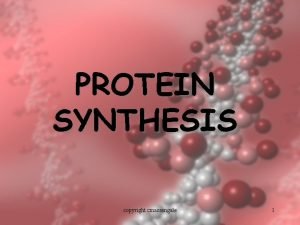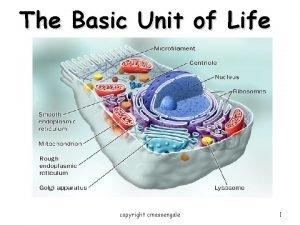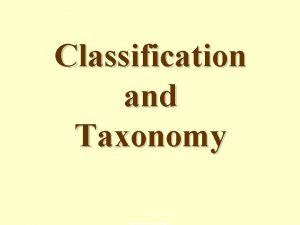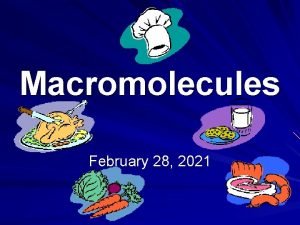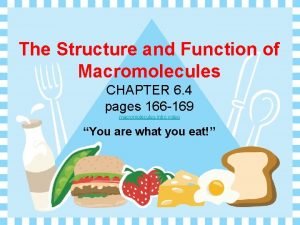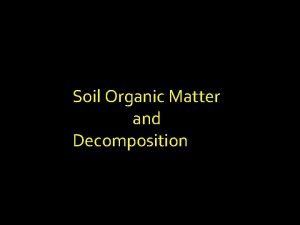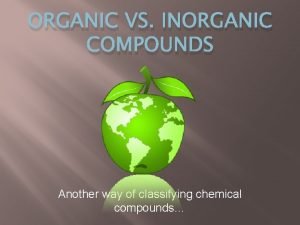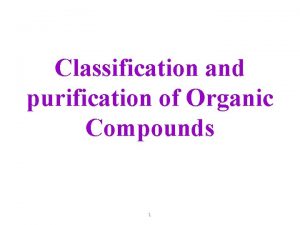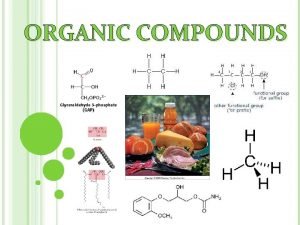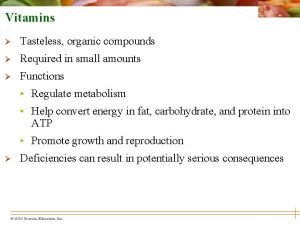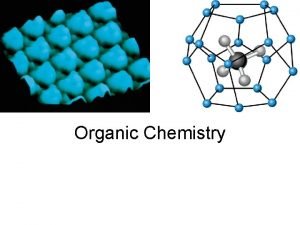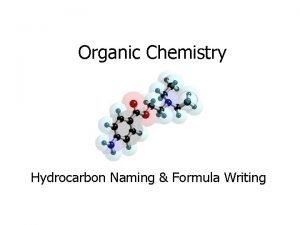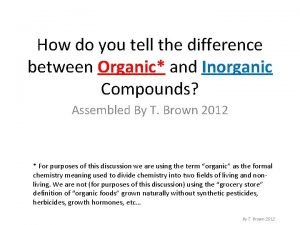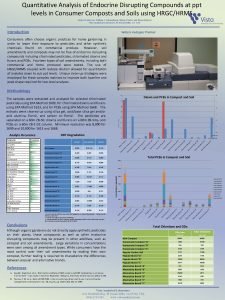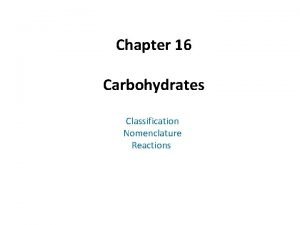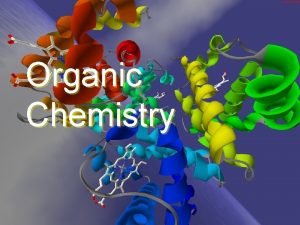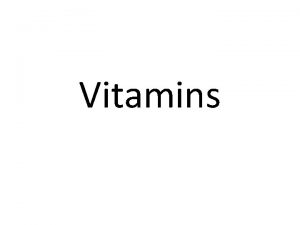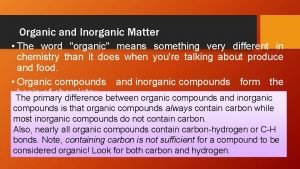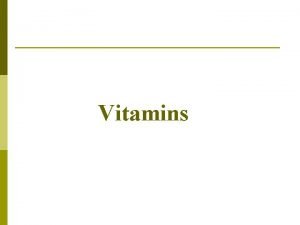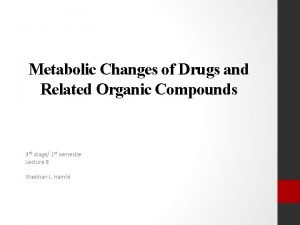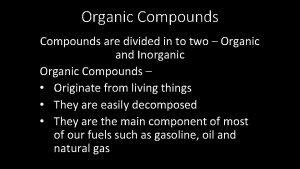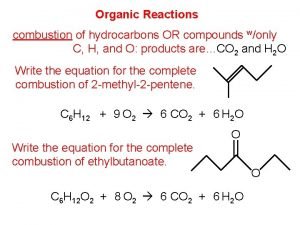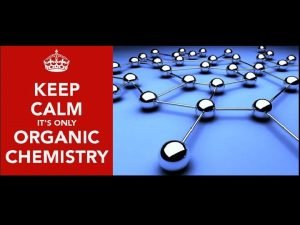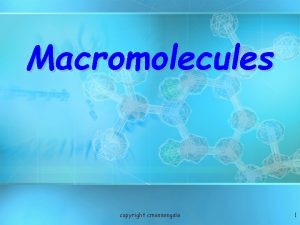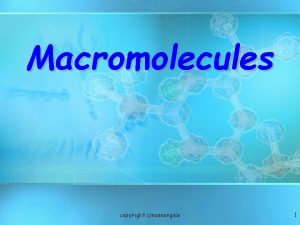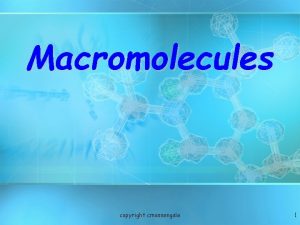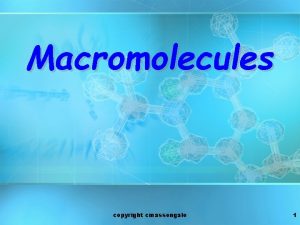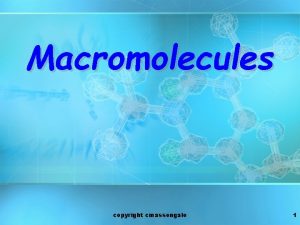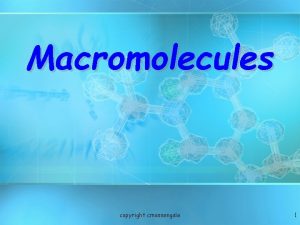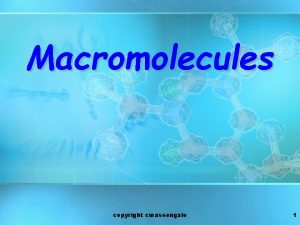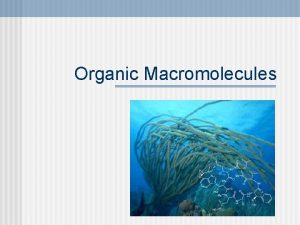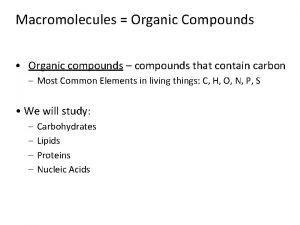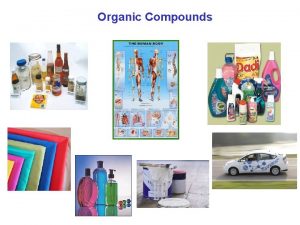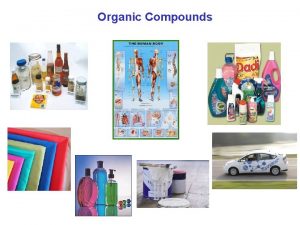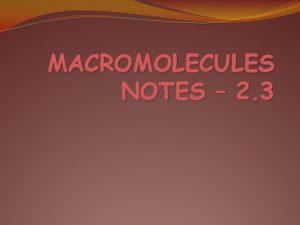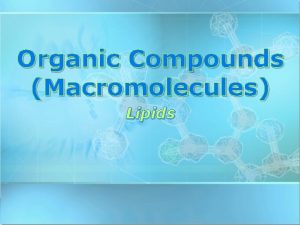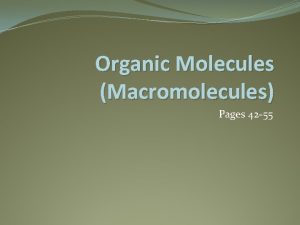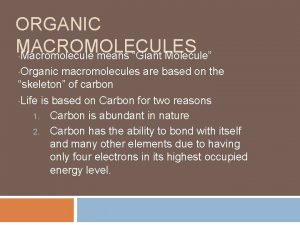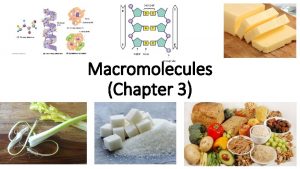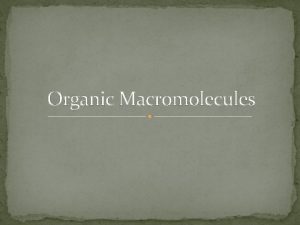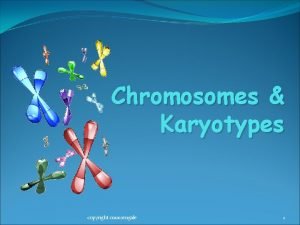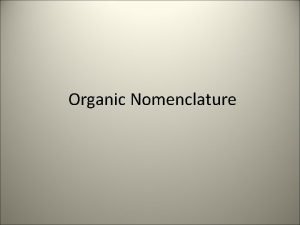Macromolecules copyright cmassengale 1 Organic Compounds Compounds that





































- Slides: 37

Macromolecules copyright cmassengale 1

Organic Compounds • Compounds that contain CARBON are called organic • Macromolecules are large organic molecules copyright cmassengale 2

Carbon (C) • Carbon has 4 electrons in outer shell. • Carbon can form covalent bonds with as many as 4 other atoms (elements). • Usually with C, H, O or N. N • Example: CH 4(methane) copyright cmassengale 3

Macromolecules • • • Large organic molecules. Also called POLYMERS Made up of smaller “building blocks” called MONOMERS • Examples: 1. Carbohydrates 2. Lipids 3. Proteins 4. Nucleic acids (DNA and RNA) copyright cmassengale 4

Carbohydrates copyright cmassengale 5

Carbohydrates • Small sugar molecules to large sugar molecules • Saccharum is latin for sugar • Examples: A. monosaccharide B. disaccharide C. polysaccharide copyright cmassengale 6

Carbohydrates Monosaccharide: one sugar unit Examples: glucose (C ( 6 H 12 O 6) deoxyribose glucose Fructose Galactose copyright cmassengale 7

Carbohydrates Disaccharide: two sugar unit Examples: – Sucrose (glucose+fructose) – Lactose (glucose+galactose) – Maltose (glucose+glucose) glucose copyright cmassengale 8

Carbohydrates: Structure • Simple – Disaccharides = two sugar units • Sucrose = glucose + fructose table sugar • Lactose = glucose + galactose milk sugar • Maltose = glucose + glucose seed sugar

Carbohydrates: Structure • Complex – Polysaccharides= many sugar units • • Starch -- storage in plants Glycogen -- storage in animals Cellulose -- plant cell walls, indigestible Chitin -- exoskeletons of insects, fungal cell walls

Carbohydrates Polysaccharide: many sugar units Examples: starch (bread, potatoes) glycogen (beef muscle) cellulose (lettuce, corn) glucose glucose copyright cmassengale glucose cellulose glucose 11


Chitin

Carbohydrates: Functions • Energy source • Structural component • Cell-cell communication

Carbohydrates: Dietary Recommendations • 58% of calories from carbohydrates • No more than 10% of calories from simple, refined sugars • Emphasize – Complex Carbohydrates • Starch • Fiber (cellulose) – Naturally-occurring simple carbohydrates • Fructose from fruit • Lactose from milk

Macronutrients As Energy Sources

Applying Your Knowledge 1. Monosaccharide 2. Polysaccharide 3. Disacharide A. Which molecule consists of two sugar units? B. Which choice best describes glycogen? C. Which type of molecule provides the basic energy for your cells? D. Which type of molecule is found

Lipids copyright cmassengale 18

Lipids • General term for compounds which are not soluble in water • Lipids are soluble in hydrophobic solvents • Remember: “stores the most energy” • Examples: 1. Fats 2. Phospholipids 3. Oils 4. Waxes 5. Steroid hormones cmassengale 6. copyright Triglycerides 19

Lipids Six functions of lipids: 1. Long term energy storage 2. Protection against heat loss (insulation) 3. Protection against physical shock 4. Protection against water loss 5. Chemical messengers (hormones) 6. Major component of membranes (phospholipids) copyright cmassengale 20

Lipids Triglycerides: composed of 1 glycerol and 3 fatty acids H = O H-C----O C-CH 2 -CH 2 -CH 2 -CH 2 -CH 2 -CH 3 O fatty acids H-C----O C-CH -CH = 2 2 2 CH -CH H 2 -C H 2 C Hglycerol 2 C H = = copyright cmassengale 3 21

Fatty Acids There are two kinds of fatty acids you may see these on food labels: = 1. Saturated fatty acids: no double bonds (bad) O saturated C-CH 2 -CH 2 -CH 2 -CH 3 = 2. Unsaturated fatty acids: double bonds (good) O unsaturated C-CH 2 -CH=CH -CH copyright cmassengale 2 -C H 2 C H 3 22

Proteins copyright cmassengale 23

Proteins (Polypeptides) • Amino acids (20 different kinds of aa) bonded together by peptide bonds (polypeptides). polypeptides • Six functions of proteins: 1. Storage: albumin (egg white) 2. Transport: hemoglobin 3. Regulatory: hormones 4. Movement: muscles 5. Structural: membranes, hair, nails 6. Enzymes: cellular reactions copyright cmassengale 24

copyright cmassengale 25

Proteins (Polypeptides) Four levels of protein structure: A. Primary Structure B. Secondary Structure C. Tertiary Structure D. Quaternary Structure copyright cmassengale 26

Primary Structure Amino acids bonded together by peptide bonds (straight chains) Amino Acids (aa) aa 1 aa 2 aa 3 aa 4 aa 5 aa 6 Peptide Bonds copyright cmassengale 27

Secondary Structure • 3 -dimensional folding arrangement of a primary structure into coils and pleats held together by hydrogen bonds • Two examples: Alpha Helix Beta Pleated Sheet Hydrogen Bonds copyright cmassengale 28

Tertiary Structure • Secondary structures bent and folded into a more complex 3 -D arrangement of linked polypeptides • Bonds: H-bonds, ionic, disulfide bridges (S-S) • Call a “subunit”. Alpha Helix Beta Pleated Sheet copyright cmassengale 29

Quaternary Structure • Composed of 2 or more “subunits” • Globular in shape • Form in Aqueous environments • Example: enzymes (hemoglobin) subunits copyright cmassengale 30

copyright cmassengale 31

Nucleic Acids copyright cmassengale 32

Nucleic acids • Two types: a. Deoxyribonucleic acid (DNAdouble helix) b. Ribonucleic acid (RNA-single strand) • Nucleic acids are composed of long chains of nucleotides linked by dehydration synthesis copyright cmassengale 33

Nucleic acids • Nucleotides include: phosphate group pentose sugar (5 -carbon) nitrogenous bases: adenine (A) thymine (T) DNA only uracil (U) RNA only cytosine (C) guanine (G) copyright cmassengale 34

Nucleotide Phosphate Group O O=P-O O 5 CH 2 O N C 4 Sugar (deoxyribose) C 1 3 cmassengale Ccopyright C 2 Nitrogenous base (A, G, C, or T) 35

5 DNA double helix O 3 3 P 5 O O C G 1 P 5 3 2 4 4 2 3 P 1 T 5 A P 3 O O P 5 O 3 copyright cmassengale 5 P 36

copyright cmassengale 37
 Cmassengale
Cmassengale Cmassengale
Cmassengale Genus species
Genus species Macromolecules chart
Macromolecules chart What is this
What is this Block av độ 1
Block av độ 1 Tìm độ lớn thật của tam giác abc
Tìm độ lớn thật của tam giác abc Sau thất bại ở hồ điển triệt
Sau thất bại ở hồ điển triệt Thể thơ truyền thống
Thể thơ truyền thống Hãy nói thật ít để làm được nhiều
Hãy nói thật ít để làm được nhiều Thơ thất ngôn tứ tuyệt đường luật
Thơ thất ngôn tứ tuyệt đường luật Tôn thất thuyết là ai
Tôn thất thuyết là ai Phân độ lown ngoại tâm thu
Phân độ lown ngoại tâm thu Walmart thất bại ở nhật
Walmart thất bại ở nhật Gây tê cơ vuông thắt lưng
Gây tê cơ vuông thắt lưng Organic chemistry introduction
Organic chemistry introduction Decomposition of organic compounds
Decomposition of organic compounds Families of organic compounds
Families of organic compounds Organic vs inorganic compounds
Organic vs inorganic compounds Thin layer chromatography principle
Thin layer chromatography principle All organic compounds must contain the element
All organic compounds must contain the element Absorption of water soluble vitamins
Absorption of water soluble vitamins Classification of hydrocarbons
Classification of hydrocarbons Condensed formula
Condensed formula Vitamins are organic compounds
Vitamins are organic compounds Organic vs inorganic compounds
Organic vs inorganic compounds Charring test of organic and inorganic compounds
Charring test of organic and inorganic compounds Quantitative analysis of organic compounds ppt
Quantitative analysis of organic compounds ppt Reactions of organic compounds
Reactions of organic compounds Organic compounds must contain:
Organic compounds must contain: Classification of vitamins chart
Classification of vitamins chart Organic versus inorganic compounds
Organic versus inorganic compounds Vitamins are organic compounds that
Vitamins are organic compounds that Metabolic changes of drugs and related organic compounds
Metabolic changes of drugs and related organic compounds Purification and characterization of organic compounds
Purification and characterization of organic compounds What is the classification of organic compounds
What is the classification of organic compounds Organic compound combustion
Organic compound combustion Type of organic compounds
Type of organic compounds
